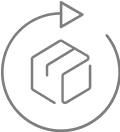Two of the most ubiquitous pieces of kitchen linen around are the tea towel and the tablecloth.
And yet, we never question their origins. We act as if they’ve always been sitting there in our kitchens, ready for use. Well, for our ancestors centuries ago they weren’t. Read this article and learn something new:
Origin of the tea towel
Typically made from linen or cotton, the tea towel (or kitchen towel) is durable, absorbent and doesn’t leave lint or marks after drying.
But it began its life in ancient China as silk originally. It was actually used to draw on (usually maps) and was easily hidden in a shoe or sewn into a jacket. Artist Vincent Van Gogh used a tea cloth to paint on when there was no canvas at his disposal.
The naming of the tea towel dates back to Victorian England where it was common to serve tea for friends in the drawing room. Eventually afternoon tea became supper. This was served on the finest china and, to protect it, a cloth was used. This was a dedicated cloth in that it was used for serving the finest china at tea time only.
The material of choice for the ‘tea cloth’ was linen due to the fact it was so absorbent and left no lint behind. Servants often embroidered the tea towels to make them fancier for the tea ceremony.
In America the tea towel had more industrial beginnings. It began as a sack cloth, for storing flour, sugar, grains etc. Slogans and logos were printed on them, and even embroidery at times.
Smart housewives reused the sack cloths as tea towels and would swap them with one another for different patterns. To this day the ‘flour sack towel’ remains a favourite tea towel, again for its absorbency and refusal to leave behind lint.
Origin of the tablecloth
It wasn’t until the mid to late 19th century and the advent of cotton mills in England and the first cotton processing plant in America that the tablecloth really made its appearance on both sides of the pond.
The factories made producing pieces of linen easier and quicker so tablecloths and napkins became familiar in kitchens throughout the Southern States of America and in England.
What really made a difference to its popularity though was the sewing machine. A rejection of the mass production of the cotton mills meant a desire for individual cloths women could work on at home with a sewing machine. This chimed with the philosophy of the Arts and Crafts movement at the time.
@TheArtStory says: “[William Morris] emphasised the use of handcraft as opposed to machine production, creating works of very high quality that he ultimately hoped would inspire cottage industries among the working classes and bring pleasure to their labour, thus creating a kind of democratic art.”
The Art Nouveau style, which first appeared in Paris spurned the Victorian dark tablecloths and napkins in favour of lighter, pastel shades – colours that could be found in the garden and nature in general. Art Deco in the 1920s added pattern. Today’s technology means we can add just about any design we like. But here at Solino Home we like to embrace the beauty of the linen itself by keeping it plain most of the time.



















